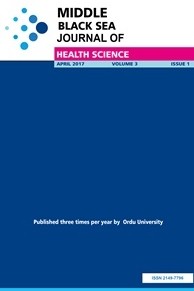Doğu Karadeniz Bölgesi Erişkin Popülasyonda Ankete Dayalı Besin Alerji Prevelansı
Besin Alerjisi, Prevelans, Yetişkin, Epidemiyoloji, Anket
The Prevalence of Questionnare Based Food Allergy in Adult Population of Eastern Blacksea Region of Turkey
ult, Epidemiology, Food Hypersensitivity, Prevalence, Questionnaire,
___
- Burney PG, Potts J, Kummeling I, Mills EN, Clausen M, Dubakiene R. et.al. The prevalence and distribution of food sensitization in European adults. Allergy. 2014;69(3):365-371.
- Seth D, Poowutikul P, Pansare M, Kamat D. Food Allergy: A Review. Pediatr Ann. 2020 Jan 1;49(1):e50-e58. doi: 10.3928/19382359-20191206-01
- Kivity S. Adult-onset food allergy. Isr Med Assoc J. 2012 Jan;14(1):70-72.
- Gelincik A, Büyüköztürk S, Gül H, Işik E, Işsever H, Ozşeker F, et al. Confirmed prevalence of food allergy and non-allergic food hypersensitivity in a Mediterranean population. Clin Exp Allergy. 2008; 38(8):1333-1341. Orhan F, Karakas T, Cakir M, Aksoy A, Baki A, Gedik Y. Prevalence of immunoglobulin E-mediated food allergy in 6-9-year-old urban schoolchildren in the eastern Black Sea region of Turkey. Clin Exp Allergy. 2009;39(7):1027-1035.
- Grundy J, Matthews S, Bateman B, Dean T, Arshad SH. Rising prevalence of allergy to peanut in children: Data from 2 sequential cohorts. J Allergy Clin Immunol 2002;110(5):784-789.
- Celik G, Mungan D, Bavbek S, Sin B, Ediger D, Demirel Y, et al. The prevalence of allergic diseases and atopy in Ankara, Turkey: a two-step population-based epidemiological study. J Asthma. 1999;36(3):281-290. Asher MI, Montefort S, Björkstén B, Lai CK, Strachan DP, Weiland SK, et al. Worldwide time trends in the prevalence of symptoms of asthma, allergic rhinoconjunctivitis, and eczema in childhood: ISAAC Phases One and Three repeat multicountry cross-sectional surveys. Lancet. 2006;368(9537):733-743
- McBride D, Keil T, Grabenhenrich L, Dubakiene R, Drasutiene G, Fiocchi A, et al. The EuroPrevall birth cohort study on food allergy: baseline characteristics of 12,000 newborns and their families from nine European countries. Pediatr Allergy Immunol 2012; 23(3): 230-239.
- Roehr CC, Edenharter G, Reimann S, Ehlers I, Worm M, Zuberbier T, et al. Food allergy and nonallergic food hypersensitivity in children and adolescents. Clin Exp Allergy 2004;34 (10):1534-1541.
- Osterballe M, Mortz CG, Hansen TK, Andersen KE, BindslevJensen C. The prevalence of food hypersensitivity in young adults. Pediatr Allergy Immunol 2009;20(7): 68-92.
- Feng H, Liu Y, Xiong X, Xu Q, Zhang Z, Wu Y, Lu Y. Epidemiological survey of self-reported food allergy among university students in China. Medicine (Baltimore). 2022;101(31):e29606. doi: 10.1097/MD.0000000000029606.
- Schäfer T, Böhler E, Ruhdorfer S, Weigl L, Wessner D, Heinrich J, et al. Epidemiology of food allergy/food intolerance in adults: associations with other manifestations of atopy. Allergy. 2001;56(12):1172–1179.
- Woods RK, Abramson M, Bailey M, Walters EH. International prevalences of reported food allergies and intolerances. Comparisons arising from the European Community Respiratory Health Survey (ECRHS) 1991-1994. Eur J Clin Nutr. 2001;55(4):298–304.
- Boyce JA, Assa'ad A, Burks AW, Jones SM, Sampson HA, Wood RA, et al. Guidelines for the diagnosis and management of food allergy in the United States: summary of the NIAID-sponsored expert panel report. Nutr Res. 2011 Jan;31(1):61-75. Eggesbø M, Botten G, Halvorsen R, Magnus P. The prevalence of CMA/CMPI in young children: The validity of parentally perceived reactions in a population-based study. Allergy 200;56(5):393-402. PMID: 11350302.
- Kondo Y, Uriso A. Oral allergy syndrome. Allergol Int 2009;58(4):485-491.
- Oberritter H. Food allergies. Zentralbl Hyg Umweltmed. 1991;191(2-3):316-326.
- Pereira B, Venter C, Grundy J, Clayton CB, Arshad SH, Dean T. Prevalence of sensitization to food allergens, reported adverse reaction to foods, food avoidance, and food hypersensitivity among teenagers. J Allergy Clin Immunol 2005;116(4):884–892.
- 20.Eggesbø M, Botten G, Stigum H, Nafstad P, Magnus P. Is delivery by cesarean section a risk factor for food allergy? J Allergy Clin Immunol 2003;112(2):420–426. PMID: 12897751.
- Dean T, Venter C, Pereira B, Arshad SH, Grundy J, Clayton CB et al. Patterns of sensitization to food and aeroallergens in the first 3 years of life. J Allergy Clin Immunol 2007;120(5):1166–1171.
- Roehr CC, Edenharter G, Reimann S, I Ehlers, M Worm, T Zuberbier, et al. Food allergy and nonallergic food hypersensitivity in children and adolescents. Clin Exp Allergy 2004; 34(10):1534-41. PMID: 15479267.
- Barlık F, Güner Ş N, Barlık M, Söğüt A, Sancak R. Prevalence of food allergy in nursery and kindergarten children in Samsun. Turk Arch Ped 2013;48: 288-293
- Yayın Aralığı: Yılda 4 Sayı
- Başlangıç: 2015
- Yayıncı: Ordu Üniversitesi
Fatma TANILIR ÇAĞIRAN, Zercan KALI
Determining University Students' Anxiety and Problem Solving Skills in the COVID-19 Pandemic Process
Ülkü SAYGILI DÜZOVA, Abdullah VURGUN, Güler KARA, Gülnihal PARLAK
The Impact of Carbon Monoxide İntoxication on Thiol/Disulfide Hemostasis
Özge Ebru DAĞCI VARHAN, Gülşah ÇIKRIKÇI IŞIK, Mustafa EKİCİ, Tuba ŞAFAK, Şeref Kerem ÇORBACIOĞLU, Yunsur ÇEVİK
Türkan Mutlu YAR, Ülkü KARAMAN, Yeliz KAŞKO ARICI
What Impact does a Pandemic have on Emergency Department Visits? COVID-19 Pandemic and Coronaphobia
Muhammet Fatih BEŞER, Engin İLHAN, Perihan ŞİMŞEK, Metin YADIGAROGLU, Abdul Samet ŞAHİN, Emre KOÇ, Esra ÜÇÜNCÜ, Özlem BÜLBÜL, Demet SAĞLAM AYKUT, Özgür ARAZ, Murat TOPBAŞ, Abdulkadir GÜNDÜZ
Investigation of Postgraduate Theses on Using of Web-Based Education in Nursing Education
Hatice YEMENOĞLU, Meltem ZİHNİ KORKMAZ, Medeni ARPA
Feyza AKTAŞ REYHAN, Elif DAĞLI
Osman Eren ÇETİNKAYA, İlke ÖZER ASLAN, Alev KURAL, Keziban DOĞAN
Analysis of 55 Adult Cases Surgically Treated for Pontocerebellar Angle Tumors
